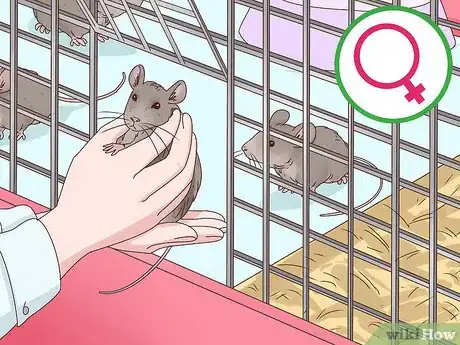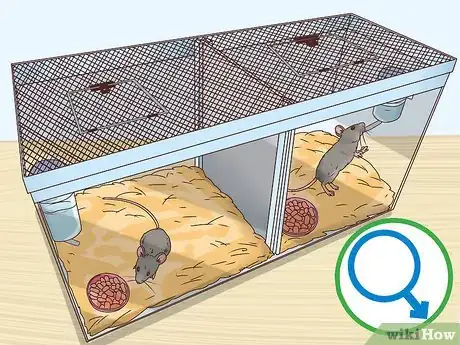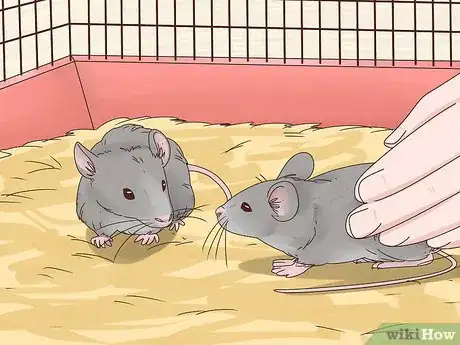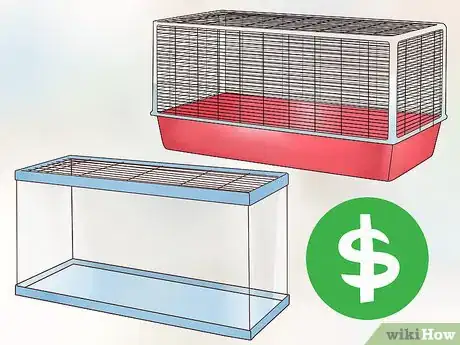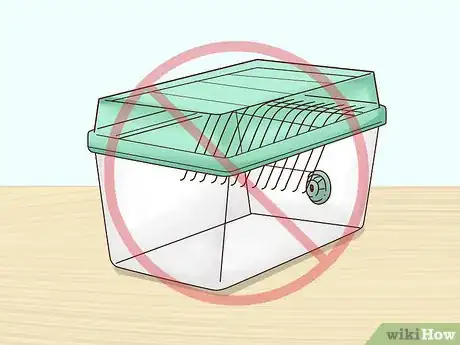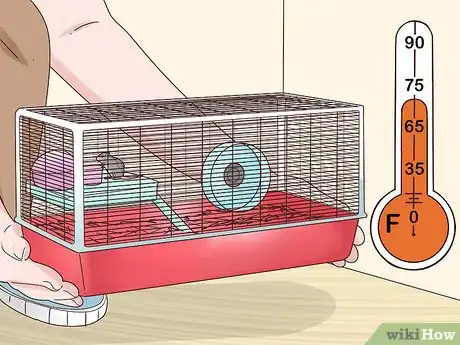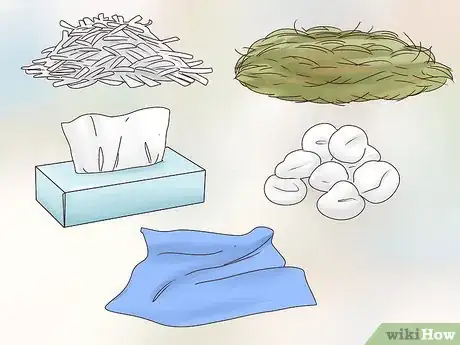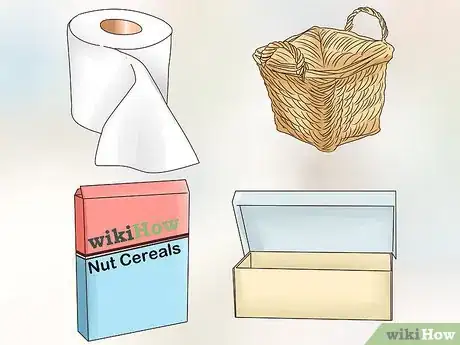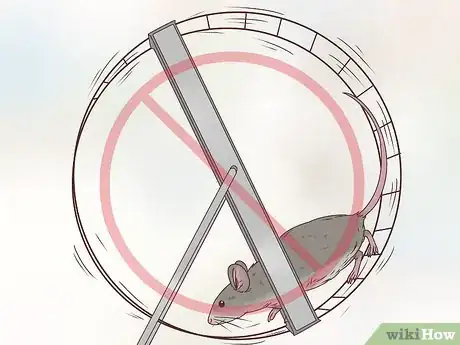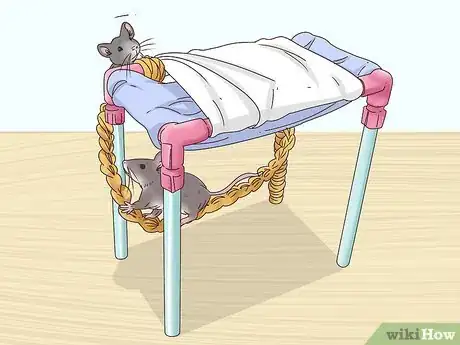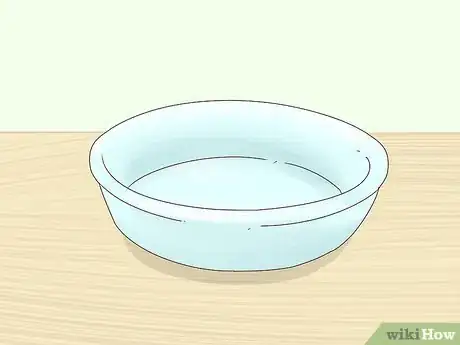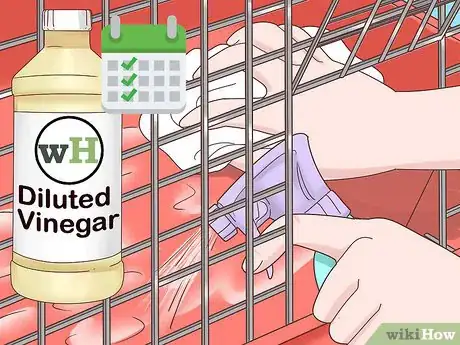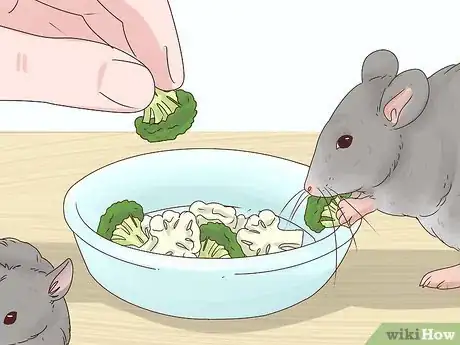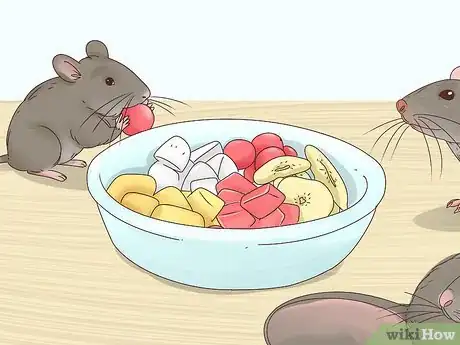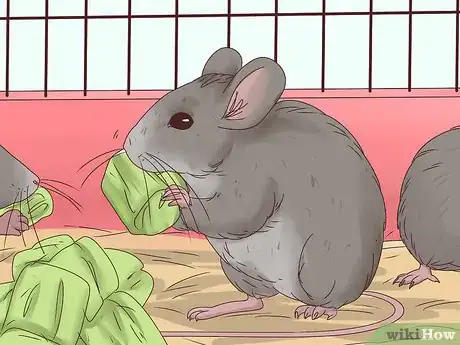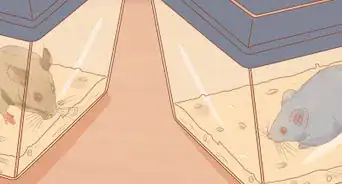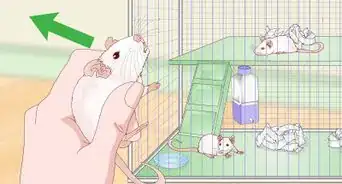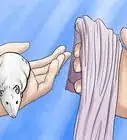This article was co-authored by Pippa Elliott, MRCVS. Dr. Elliott, BVMS, MRCVS is a veterinarian with over 30 years of experience in veterinary surgery and companion animal practice. She graduated from the University of Glasgow in 1987 with a degree in veterinary medicine and surgery. She has worked at the same animal clinic in her hometown for over 20 years.
There are 11 references cited in this article, which can be found at the bottom of the page.
wikiHow marks an article as reader-approved once it receives enough positive feedback. In this case, 91% of readers who voted found the article helpful, earning it our reader-approved status.
This article has been viewed 23,140 times.
Mice can be entertaining and loving animal companions. To keep multiple mice happy and healthy, you need the right housing, environment, bedding, food, and toys. When you accomplish these things, your mouse family will love you as much as you love them, and they will live in harmony with each other.
Steps
Introducing Multiple Mice
-
1Buy at least 2 female mice because mice are social animals. Two females are ideal to start with because they get along and can be kept together better than male mice, who are more aggressive. Lonely mice become depressed easily and will die from loneliness by not eating and wasting away.
- Start out with 2 mice that are the same size. Female mice are ideal because they’re less aggressive than males.
- It’s best not to risk letting 2 male mice live in a cage together unless one of them is neutered. Male mice usually fight, and it can end in injury or death.
-
2Put female mice together to avoid loneliness. Female mice usually like each other’s company, so they won’t fight, and they can’t breed. If the females did not grow up together, you need to introduce them properly.[1]
- Females should be kept in groups of 3 or more. This allows them to comfort each other if one of them loses her female companion. A female mouse can actually die from a broken heart if her companion dies.[2]
- A third mouse also helps balance the relationships among the female group. For instance, if there’s an alpha female, 2 more mice will make sure she doesn’t get too bossy with 1 mouse. Two mice give her more to focus on.[3]
- Introducing female mice to each other will take some work, but it’s usually successful. If they fight, separate them for 24 hours to a week and try again. More than one try may be needed, but they will find a group or companion they get along with, just like humans.[4]
Advertisement -
3Separate males from each other to avoid fighting. Male mice will fight with each other no matter how long they live together. They’ve learned to fight to the death since they were littermates, so a solo male is actually happier with toys and attention from his human.[5]
- Be careful that your male mouse doesn’t get too lonely. There are ways to give them company. The lonely male mouse may tolerate a neutered male because he’s less aggressive than an intact male.[6]
- Don’t keep a male and female mouse together unless you get the male neutered. Otherwise, they will have babies.[7]
-
4Create a neutral territory to introduce mice to each other. Neutral territory is a cage or tank set up to be different than the one mice are already living in. It is clean and free of the odors of other mice.[8]
- Supervise your mice when introducing them to others in neutral territory, because one moment they may get along well, and the next they may be fighting. You should be there with them to break up the fight and separate them when needed.[9]
- Carry their neutral tank around with you from room to room just to be there if a mouse fight breaks out.[10]
- Don’t stick your hand in the middle of a mouse fight. Use a toilet paper roll to break fighting mice, or else you’ll get bit. If there’s fighting that involves blood and wounds, separate the mice into different containers right away. However, it’s normal for mice to argue by nipping, kicking and squeaking at each other. No intervention is needed for mouse arguing.[11]
-
5Make the mice smell the same when introducing them. One alternative method is to dab a bit of vanilla on their rear ends to make all the mice smell the same to each other. They’re more likely to accept each other easier in the initial introduction. However, it won’t prevent fighting.[12]
-
6Add a mouse playground to distract them. Mice are more concerned with their surroundings, so having lots of distractions like toys and things to climb in their tank or cage will help them to get acquainted better.[13]
- After this play time, put them in their neutral tank, and keep an eye on them.[14]
Buying the Right Housing
-
1Buy the right kind of housing for your mice to be comfortable. Two ideal forms of enclosures for multiple mice are aquariums and wire cages. Aquariums are glass containers with mesh lids that are ideal at preventing these escape artists from getting out. Wire cages sit on top of a plastic base with different levels inside for your critters to climb.[15]
- Aquarium cages can be found in the aquatic animal sections of pet supply stores.[16]
- For multiple mice, avoid aquariums of less than 10 gallons (37.9 L). So if you start with 2 or 3 mice, buy a 10 US gal (38 L) tank. Buy a 15 US gal (57 L) tank for 4-5 mice and a 20 US gal (76 L) tank for 4-6 mice.[17]
- Use a wire cage with bars that are a 1⁄4 in (0.64 cm) or less apart. If a mouse can fit its head through, it will be able to escape or possibly get stuck.[18]
-
2Avoid using shoeboxes, cages, or wood enclosures. Some of these are still marketed despite the dangers they pose to your fuzzy friends.[19]
- Habitats are colorful containers with tubes, tunnels, and other built-in accessories. While these look cute, they are difficult to clean, poorly ventilated, undersized, and vulnerable to gnawing.[20]
- Avoid shoebox cages for their poor ventilation. They are hard to clean and don’t have enough space for exercise toys, so they’re not ideal for a mouse, let alone several mice. These are also plastic and susceptible to gnawing. [21]
- Wood enclosures are always bad ideas for rodents because they are extremely vulnerable to death by gnawing and will be reduced to sawdust in no time. [22]
-
3Put the container in the right place with proper conditions. Mice can become too hot or too cold when the temperature isn’t between 65–75 °F (18–24 °C). They’re also sensitive to bright lights, so put them where the lighting is dim and gentle.[23]
- Keep their homes away from strong sources of heat such as sunlight, wood stoves, and fireplaces, especially glass aquariums. Glass absorbs heat and will overheat the mice.[24]
Setting Up Home
-
1Line the bottom with newspaper, shredded hay, and shredded paper. Add some tubes and little houses. Avoid pine and cedar shavings because they can cause liver damage, respiratory problems and skin disorders in mice.
-
2Provide lots of bedding for nests. Shredded paper, timothy hay, tissues, cotton balls, paper towels, napkins and pieces of cloth are ideal because they won’t cause health problems in mice.
-
3Give your mice things they can climb in. Toilet paper and paper towel rolls, small wicker baskets without dyes or glues, cereal boxes, and shoeboxes are things they can climb in and gnaw on.
- Mice love hollowed out items such as coconuts and hollowed stale bread loaves, so you can make a coconut house or a bread loaf tunnel for them to not only have fun poking in and out of, but also to eat.
-
4Avoid exercise wheels for the hazards they pose to mice. Wheels were made for hamsters because they have very short tails. Mice have long tails that can get stuck in the bars of an exercise wheel and injure them.
- As an alternative to wire wheels, solid surface wheels are preferable.[25]
-
5Use alternative accessories such as PVC piping for nests. These can be found at the hardware store. Clay pottery with holes drilled in is also fun for mice to poke their heads through and nest in.[26]
-
6Provide a shallow ceramic or porcelain food bowl. These are harder to tip over than deeper metal bowls, and they also can’t get chewed up like plastic bowls.[27]
-
7Use a gravity-fed drip water bottle that hangs down the side of the cage. You hang it on the opening of the aquarium or tank and then cover the enclosure. The water won’t get dirty, and it can’t spill. These can be bought at pet supply stores. [28]
- One adult mouse needs 1–1 1⁄2 tsp (4.9–7.4 ml) of water a day, so a cage of 3 mice should have one adequately sized water bottle to hydrate them all.[29]
-
8Clean the aquarium or cage every week with diluted vinegar. Rinse the vinegar thoroughly from the enclosure. Replace the bedding, but leave some or a toy uncleaned, so the mouse will feel comfort from a familiar scent when they are placed into their cage. Do spot cleaning every 3 or 4 days.[30]
- Remove the mouse before cleaning the cage. There are small, plastic carriers to put the mice in temporarily while cleaning.[31]
Feeding Your Mice
-
1Buy commercial mouse pellets available at pet stores. You can also mix safe fruits and vegetables with these pellets for a diverse diet.[32]
- Have some fun by scattering the pellets around the cage rather than always putting the food in the bowl. Mice scavenge for their food in the wild, so you can recreate this by placing it in different areas of the cage or tank.[33]
- Hide treats inside paper bags or cardboard tubes that the mice can chew threw.[34]
-
2
-
3Mix fruit into their diet. Mice can eat apples with seeds removed, peaches, melon, pear, dried banana and red grapes. Don’t feed them citrus fruits such as lemons, oranges, and grapefruits.[37]
-
4Give them a lot to gnaw on. Diversify their chewing toys with items such as coconut shells, hay cubes, unbleached loofah, pumice stone and seagrass.[38]
Warnings
References
- ↑ https://www.petmousefanciers.com/t19-keeping-mice-together-introducing-them
- ↑ https://www.petmousefanciers.com/t19-keeping-mice-together-introducing-them
- ↑ https://www.petmousefanciers.com/t19-keeping-mice-together-introducing-them#35
- ↑ https://www.petmousefanciers.com/t19-keeping-mice-together-introducing-them#69
- ↑ https://www.petmousefanciers.com/t19-keeping-mice-together-introducing-them#35
- ↑ https://animalcorner.co.uk/animals/mice/
- ↑ https://www.petmousefanciers.com/t19-keeping-mice-together-introducing-them#69
- ↑ https://www.petmousefanciers.com/t19-keeping-mice-together-introducing-them#69
- ↑ https://www.petmousefanciers.com/t19-keeping-mice-together-introducing-them#69
- ↑ https://www.petmousefanciers.com/t19-keeping-mice-together-introducing-them#69
- ↑ https://www.petmousefanciers.com/t19-keeping-mice-together-introducing-them#69
- ↑ https://www.petmousefanciers.com/t19-keeping-mice-together-introducing-them#69
- ↑ https://www.petmousefanciers.com/t19-keeping-mice-together-introducing-them#69
- ↑ https://www.petmousefanciers.com/t19-keeping-mice-together-introducing-them#69
- ↑ http://www.humanesociety.org/animals/mice/tips/mouse_housing.html
- ↑ http://www.humanesociety.org/animals/mice/tips/mouse_housing.html
- ↑ http://www.humanesociety.org/animals/mice/tips/mouse_housing.html
- ↑ http://www.humanesociety.org/animals/mice/tips/mouse_housing.html
- ↑ http://www.humanesociety.org/animals/mice/tips/mouse_housing.html
- ↑ http://www.humanesociety.org/animals/mice/tips/mouse_housing.html
- ↑ http://www.humanesociety.org/animals/mice/tips/mouse_housing.html
- ↑ http://www.humanesociety.org/animals/mice/tips/mouse_housing.html
- ↑ http://www.humanesociety.org/animals/mice/tips/mouse_housing.html
- ↑ http://www.humanesociety.org/animals/mice/tips/mouse_housing.html
- ↑ https://www.thesprucepets.com/choosing-and-caring-for-pet-mice-1236741
- ↑ https://www.thesprucepets.com/choosing-and-caring-for-pet-mice-1236741
- ↑ https://www.thesprucepets.com/choosing-and-caring-for-pet-mice-1236741
- ↑ http://nswschoolanimals.com/mice/mice-food-water/
- ↑ http://nswschoolanimals.com/mice/mice-food-water/
- ↑ https://www.vetbabble.com/small-pets/mice/
- ↑ https://www.vetbabble.com/small-pets/mice/
- ↑ https://www.pdsa.org.uk/taking-care-of-your-pet/looking-after-your-pet/small-pets/feeding-your-mice
- ↑ https://www.pdsa.org.uk/taking-care-of-your-pet/looking-after-your-pet/small-pets/feeding-your-mice
- ↑ https://www.pdsa.org.uk/taking-care-of-your-pet/looking-after-your-pet/small-pets/feeding-your-mice
- ↑ https://www.pdsa.org.uk/taking-care-of-your-pet/looking-after-your-pet/small-pets/feeding-your-mice
- ↑ https://www.pdsa.org.uk/taking-care-of-your-pet/looking-after-your-pet/small-pets/feeding-your-mice
- ↑ https://www.pdsa.org.uk/taking-care-of-your-pet/looking-after-your-pet/small-pets/feeding-your-mice
- ↑ https://www.pdsa.org.uk/taking-care-of-your-pet/looking-after-your-pet/small-pets/feeding-your-mice
- ↑ https://www.vetbabble.com/small-pets/mice/
- ↑ https://www.vetbabble.com/small-pets/mice/
- ↑ http://www.humanesociety.org/animals/mice/tips/mouse_housing.html
- ↑ http://www.humanesociety.org/animals/mice/tips/mouse_housing.html

